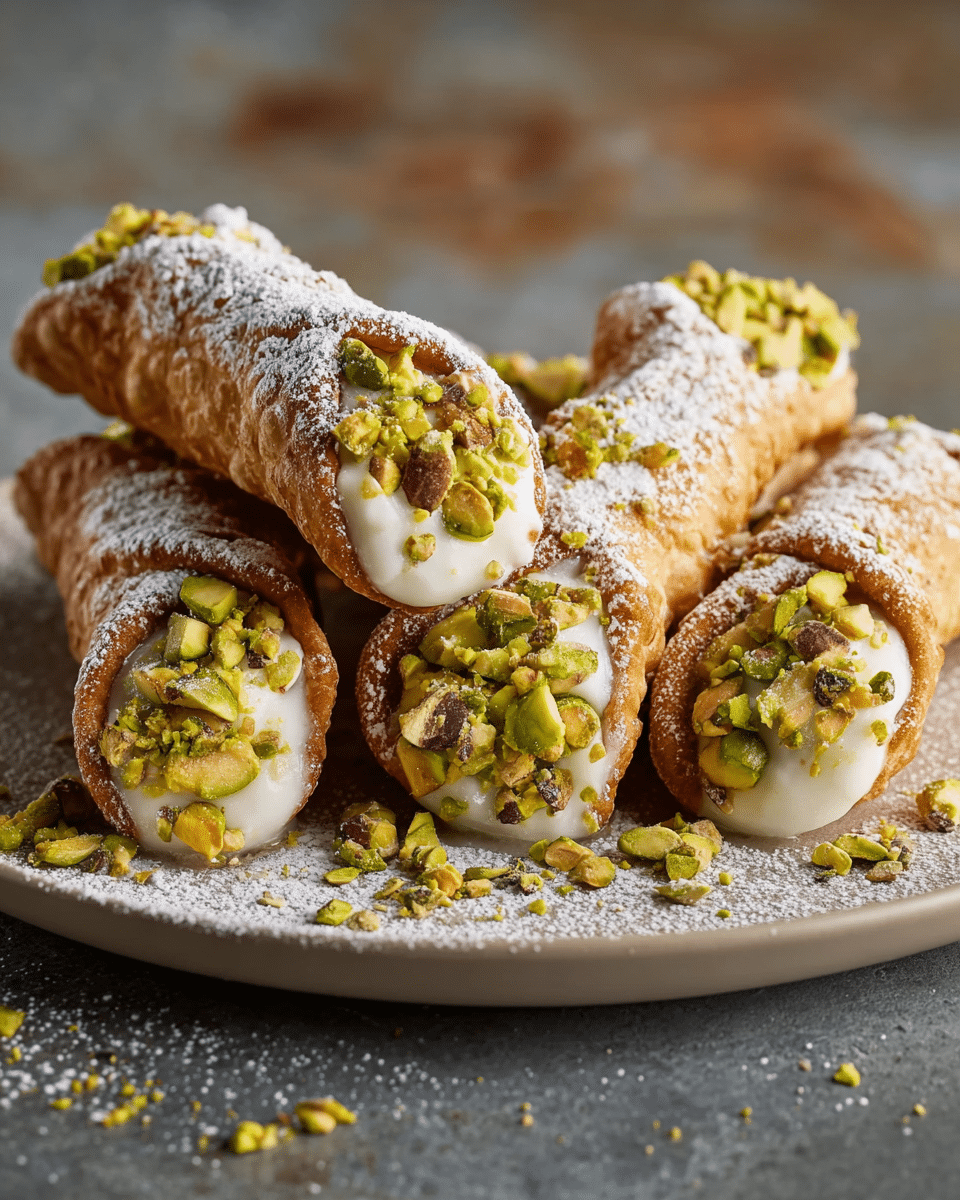Pistachio Cannoli is a delicious Italian dessert, featuring crispy pastry shells filled with a creamy pistachio ricotta filling. This treat captures the nutty flavors of pistachios, combined with smooth ricotta and sweetened with powdered sugar, making each bite a delightful indulgence. Although making cannoli from scratch may seem challenging, this step-by-step guide will walk you through each part of the process, ensuring that your pistachio cannoli come out crispy, creamy, and absolutely perfect.
Full Recipe:
Ingredients
For the Cannoli Shells
-
2 cups (250g) all-purpose flour
-
2 tablespoons sugar
-
1 teaspoon unsweetened cocoa powder
-
¼ teaspoon salt
-
2 tablespoons unsalted butter (cold and cubed)
-
1 large egg yolk
-
½ cup Marsala wine (or white wine for crispiness)
-
1 tablespoon white vinegar
-
1 egg white (for sealing the shells)
-
Vegetable oil (for frying)
For the Pistachio Ricotta Filling
-
2 cups (450g) whole milk ricotta cheese, well-drained
-
¾ cup powdered sugar (adjust to taste)
-
½ cup pistachio paste (or homemade pistachio paste)
-
½ teaspoon vanilla extract
-
¼ cup crushed pistachios (for garnish)
For Decoration
-
½ cup crushed pistachios
-
½ cup mini chocolate chips (optional)
-
Powdered sugar for dusting
Directions
Step 1: Prepare the Cannoli Dough
-
In a large bowl, whisk together the flour, sugar, cocoa powder, and salt.
-
Add cold butter cubes and mix until crumbly.
-
Pour in the egg yolk, Marsala wine, and vinegar, mixing until a dough forms.
-
Knead the dough on a floured surface for 5-7 minutes until smooth.
-
Wrap the dough in plastic and refrigerate for 1 hour.
Step 2: Roll and Shape the Cannoli Shells
-
Roll the dough out thin (about 1/16 inch thick) on a floured surface.
-
Cut the dough into 3 to 4-inch rounds.
-
Wrap each round around a metal cannoli tube, sealing the edges with egg white.
-
Heat vegetable oil to 375°F (190°C) in a deep pan.
Step 3: Fry the Cannoli Shells
-
Carefully lower the wrapped tubes into the hot oil and fry for 1-2 minutes until golden.
-
Drain on paper towels and cool.
-
Gently slide the shells off the tubes once slightly cooled.
Step 4: Make the Pistachio Ricotta Filling
-
Drain the ricotta cheese well, pressing it in cheesecloth to remove excess liquid.
-
In a bowl, mix ricotta, powdered sugar, pistachio paste, and vanilla extract until smooth.
-
Chill the mixture in the refrigerator for 30 minutes to firm up.
Step 5: Fill the Cannoli
-
Transfer the chilled filling to a piping bag with a round tip.
-
Pipe the filling into each shell from both ends to ensure an even distribution.
Step 6: Garnish & Serve
-
Roll the ends of the cannoli in crushed pistachios or mini chocolate chips for extra flavor and decoration.
-
Lightly dust with powdered sugar before serving.
-
Serve immediately for the best crispiness.
Storage Tips
-
Unfilled Cannoli Shells: Store unfilled shells in an airtight container at room temperature for up to 1 week. To restore crispiness, bake at 300°F (150°C) for 5 minutes before filling.
-
Filled Cannoli: Filled cannoli are best eaten fresh, but can be stored in the fridge for 1 day, covered loosely to avoid sogginess.
Nutrients (per serving)
Note: The nutritional values are approximate and based on a standard serving size.
-
Calories: 240–280 kcal
-
Total Fat: 12–15g
-
Saturated Fat: 3–4g
-
-
Cholesterol: 35–40mg
-
Sodium: 100–150mg
-
Carbohydrates: 30–35g
-
Fiber: 1g
-
Sugar: 18–20g
-
-
Protein: 5g
-
Calcium: 6% of Daily Value
-
Iron: 2% of Daily Value
This pistachio cannoli recipe results in a delightful combination of crunchy pastry and creamy, nutty filling, making it the perfect dessert to enjoy with family and friends.
The Key Ingredients: Crispy Shells, Pistachio Ricotta Filling, and Toppings
The Cannoli Shells: Crispy and Flaky
The cannoli shells are made with all-purpose flour, sugar, and a bit of cocoa powder for added depth. The dough is enriched with unsalted butter, egg yolk, and Marsala wine, which not only helps tenderize the dough but also makes the shells more crisp when fried. Marsala wine (or white wine) is often used in cannoli recipes to give the shells their signature crispiness and golden hue.
Once fried, the shells are crunchy, delicate, and the perfect vessel to hold the creamy filling. The use of egg white to seal the dough around the metal cannoli tubes ensures that the shells maintain their shape during frying.
The Pistachio Ricotta Filling: Creamy and Nutty
The filling for pistachio cannoli is made with ricotta cheese, which provides a rich and smooth texture, and pistachio paste, which infuses the filling with the distinct nutty flavor that defines this dessert. Powdered sugar is added to sweeten the filling, while vanilla extract adds a touch of warmth. The ricotta needs to be well-drained before mixing to ensure that the filling doesn’t become too watery, which could affect the texture of the cannoli.
The pistachio paste can be store-bought or homemade, but using a good-quality paste is crucial for achieving that bold pistachio flavor. Once mixed, the filling is chilled to firm it up before piping it into the crispy shells.
Toppings and Garnishes: Adding Flavor and Visual Appeal
Once filled, the cannoli are garnished with crushed pistachios for an extra burst of nuttiness. Mini chocolate chips can also be used as a decorative touch, adding both visual appeal and a sweet contrast to the pistachio filling. Finally, a light dusting of powdered sugar adds a delicate sweetness and gives the cannoli a beautiful finish.
Step-by-Step Guide to Making Pistachio Cannoli
Step 1: Prepare the Cannoli Dough
Begin by making the dough for the cannoli shells. In a large bowl, whisk together the flour, sugar, cocoa powder, and salt. Add cold, cubed butter to the dry ingredients and mix until the mixture becomes crumbly. Then, add the egg yolk, Marsala wine, and vinegar, stirring until a dough forms. Knead the dough on a floured surface for 5-7 minutes until smooth and elastic.
Wrap the dough in plastic wrap and refrigerate it for at least 1 hour to allow the flavors to meld and the dough to rest.
Step 2: Roll and Shape the Cannoli Shells
After the dough has rested, roll it out on a floured surface to about 1/16 inch thickness. Using a round cutter (about 3 to 4 inches in diameter), cut out circles of dough. Next, wrap each circle around a metal cannoli tube, sealing the edges with egg white to ensure they stay together during frying.
Step 3: Fry the Cannoli Shells
Heat vegetable oil in a deep pan to 375°F (190°C). Carefully lower the wrapped cannoli tubes into the hot oil and fry for 1-2 minutes, or until the shells turn golden brown. Use tongs to remove the cannoli shells from the oil and drain them on paper towels to remove excess oil.
Let the shells cool slightly, then gently slide them off the metal tubes. Set the shells aside to cool completely before filling them.
Step 4: Make the Pistachio Ricotta Filling
While the shells are cooling, prepare the pistachio ricotta filling. Drain the ricotta cheese well to remove excess liquid. You can press the ricotta in cheesecloth for a few hours or use a fine-mesh strainer to achieve the desired consistency.
In a bowl, combine the well-drained ricotta, powdered sugar, pistachio paste, and vanilla extract. Mix everything together until the filling is smooth and well-combined. Chill the filling in the refrigerator for 30 minutes to firm it up, making it easier to pipe into the cannoli shells.
Step 5: Fill the Cannoli Shells
Once the filling is chilled, transfer it into a piping bag fitted with a round tip. Carefully pipe the filling into both ends of each cannoli shell, ensuring that the filling is evenly distributed. Be gentle while filling to avoid breaking the delicate shells.
Step 6: Garnish and Serve
To garnish, roll the ends of each cannoli in crushed pistachios or mini chocolate chips, depending on your preference. Lightly dust with powdered sugar for a sweet finish. Serve the pistachio cannoli immediately for the best crispiness, or store them in an airtight container for up to 2 days.
Storage Tips
-
Unfilled Cannoli Shells: If you have leftover unfilled cannoli shells, store them in an airtight container at room temperature for up to 1 week. To restore crispiness, you can bake them at 300°F (150°C) for 5 minutes before filling.
-
Filled Cannoli: Cannoli are best eaten fresh, but if you need to store them, place the filled cannoli in the refrigerator for no more than 1 day. To avoid sogginess, do not store them in an airtight container.
Nutritional Breakdown and Health Considerations
Pistachio cannoli are a rich dessert, packed with delicious flavors from the cheese and pistachios. Each serving contains about 240-280 calories, with a balance of fats and carbohydrates. While they are indulgent, pistachios provide some healthy fats, and the ricotta offers a source of calcium and protein. The dish is sweetened with powdered sugar, which is typical for Italian pastries, but they can still be enjoyed in moderation as part of a balanced diet.
Why Pistachio Cannoli is Perfect for Any Occasion
Pistachio cannoli are perfect for a variety of occasions, from casual family dinners to elegant celebrations. Their crunchy texture and rich, creamy filling make them an ideal dessert for impressing guests. Additionally, the flavors of pistachio and ricotta are a timeless Italian pairing, making these cannoli a classic favorite that will never go out of style.
Whether you’re serving them for a holiday feast or as a special treat on a regular evening, pistachio cannoli will bring a touch of Italian tradition to your table. With their nutty, creamy filling and crisp shells, they are sure to delight everyone who takes a bite.
Conclusion: A Classic Italian Dessert
Pistachio Cannoli are a perfect balance of crispy, creamy, and nutty. By following this step-by-step guide, you can create an authentic Italian dessert that is as delicious as it is beautiful. With their irresistible filling and delicate, crispy shells, pistachio cannoli are a must-try for any dessert lover.

